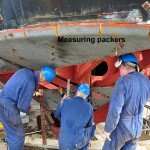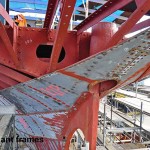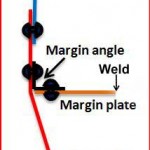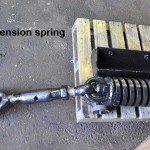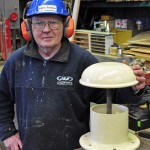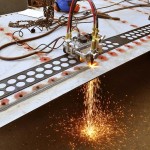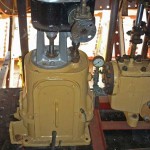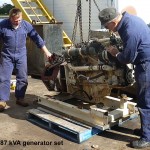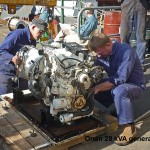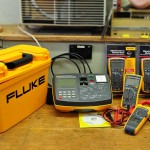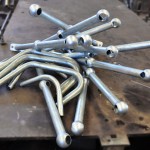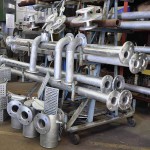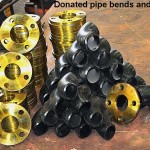John Oxley Restoration
Update July 2011
 Hull
Hull
Stern – The starboard stern plating and framing has been completed by Onzie’s team of Bill, Lindsay, Colin, Don, Steve, Geoff, John, George and others. Most of the stern deck plates have also been riveted up. Work on the port side is in an advanced state with completion in the next few months. The internal stern cant frames have been restored. Most of the frames were retained with inserts where the wastage was too much. We have learned from the work on the starboard side and our work sequence followed a different pattern. Most of the structure was left in place and only one component was being worked on. This maintained the shape better and avoided the parts to be pulled together with force.
The stern and the rest of the sheer strake is complex. It is here that the sheer strake joins with the margin angle, the margin plate and the bulwark. The sequence of assembly is critical to ensure all parts line up and that the riveting remains in the realm of the possible. To assist in this process the margin plate is cut just inside the gutter angle to avoid having to lift the rest of the wooden deck at this stage. The new plate will be welded to the new deck plate when the deck is lifted at a later stage.
The cut margin plate is replicated and the margin angle riveted to it in the workshop.
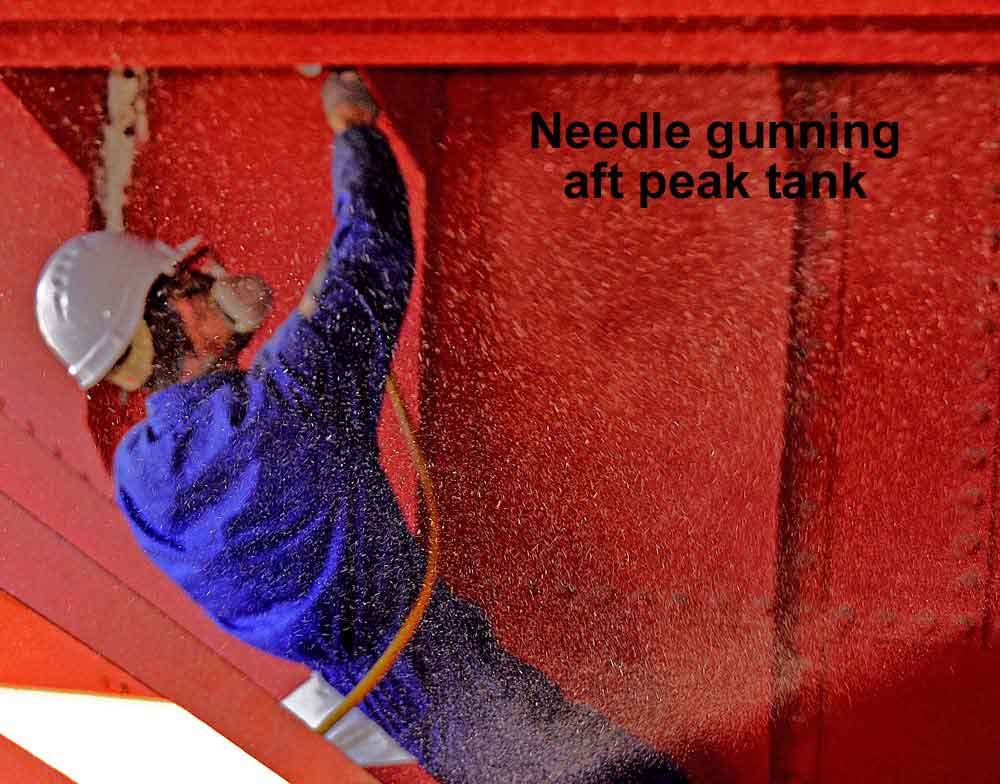
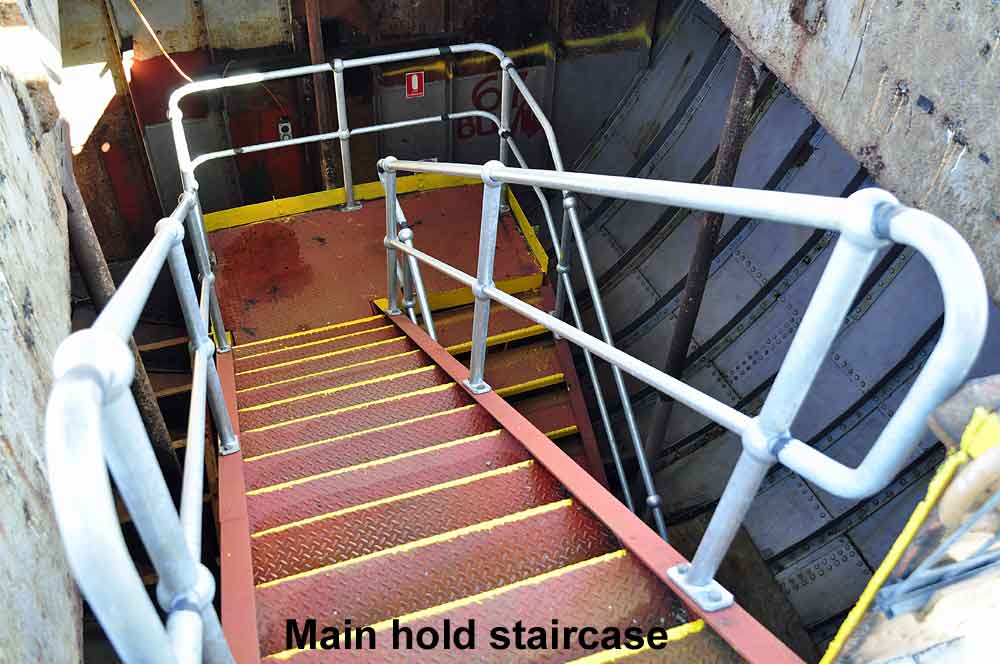 Aft peak tank – The aft peak tank has been needle gunned and painted, it looks as new.
Aft peak tank – The aft peak tank has been needle gunned and painted, it looks as new.
Main Hold – A stairway has been fabricated and fitted to give access to the main hold from the main deck. It provides easier access to the hold and an alternative escape route from the hull for safety reasons. The stancheons, rails and the galvanising were donated by industry.
The exposure to the elements and a poor paint choice on the restored parts in the main hold, from 2002, has caused corrosion on some of the frames and floors and need rust removal and is being repainted.
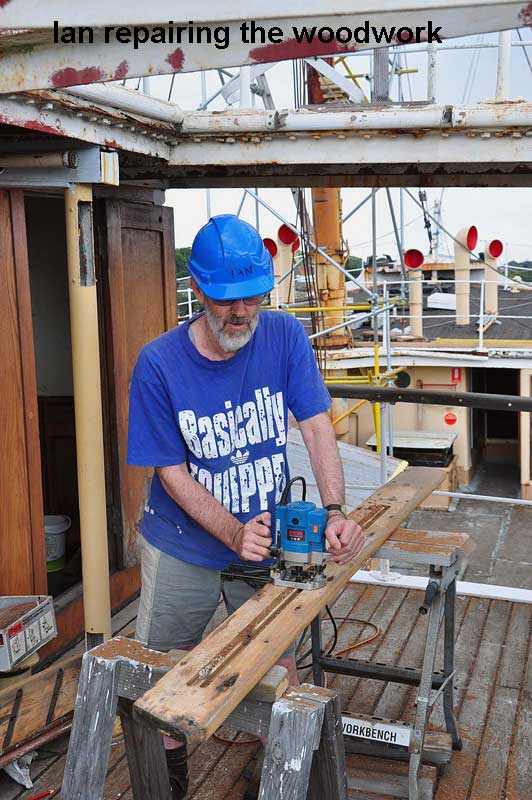
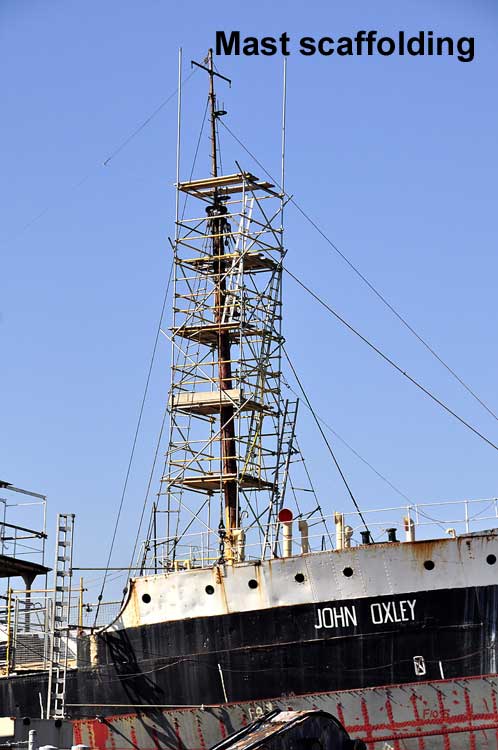 Bridge woodwork – Ian is restoring the woodwork of the bridge structure and stairways. All woodwork needs constant care to maintain the surface finishes which is under constant attack from the elements.
Bridge woodwork – Ian is restoring the woodwork of the bridge structure and stairways. All woodwork needs constant care to maintain the surface finishes which is under constant attack from the elements.
Main mast – Scaffolding has been erected by Sruart around the main mast. Work can now start on restoring the mast and to fabricate and install conduits for the electrical wiring for navigation lights and equipment.
Steering and vents – The in-line steering tension springs have been restored by Col and are stored till we are ready to install them. He is also restoring the deck vents.
New cutter – The workshop had to buy a new in-line cutter as the old one was beyond repair. The unit has already seen extensive action and is a major improvement in ease of use, safety and productivity.
Machinery
Engine room treadplates – These along with their badly rusted support frames were removed during hull replate and are being returned to establish safe working platforms. Initial task was for the workshop team to repair damaged supports – this was straightforward work, but the difficult task has been getting all the bits back into their correct place. Owen has now returned much of the engine room tread plates to their correct places. “Owen’s jig saw puzzle” will be a continuing task.
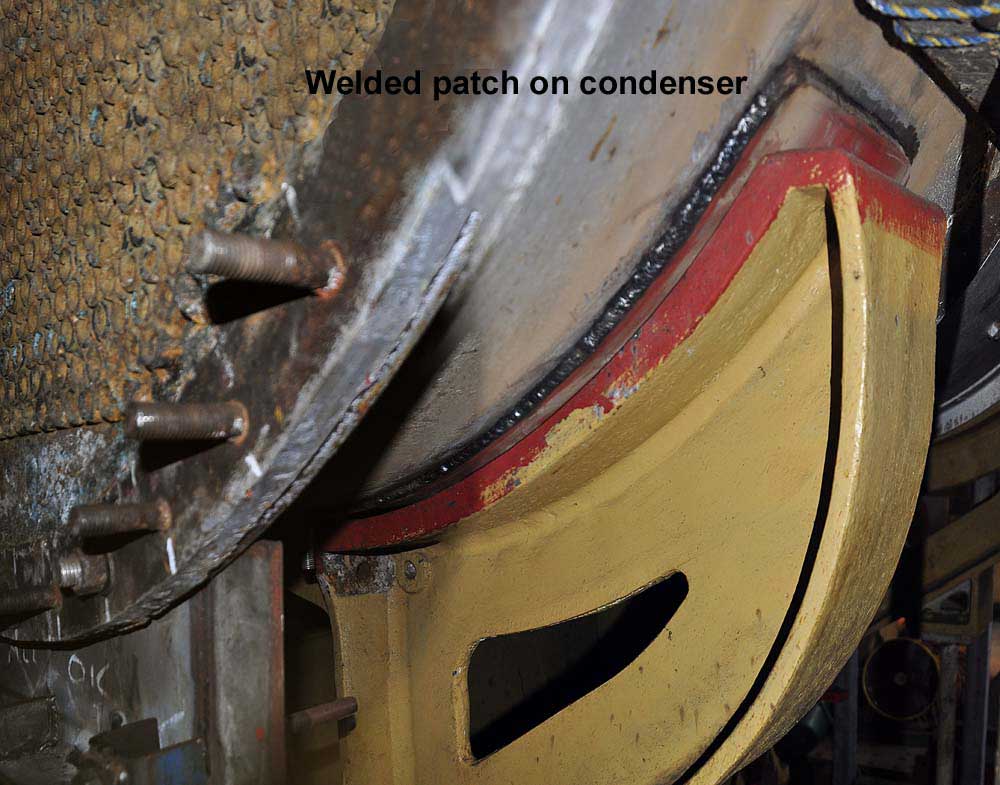 Condenser – There is some localised corrosion to the steel shell at the mounting cradles that needs repairing. It has involved lifting the condenser some 40 mm. so that new steel plates can be welded in place. This has been a difficult job, which has involved some heavy duty jacks to raise the condenser above its cradles, followed by installation of support frames, then cleaning and weld preparation and finally some difficult overhead welding. Repairs at the forward mount have taken place. Rrepairs to the aft mount are planned for later in the year. Thanks to Ian Roy and Brian for their work here.
Condenser – There is some localised corrosion to the steel shell at the mounting cradles that needs repairing. It has involved lifting the condenser some 40 mm. so that new steel plates can be welded in place. This has been a difficult job, which has involved some heavy duty jacks to raise the condenser above its cradles, followed by installation of support frames, then cleaning and weld preparation and finally some difficult overhead welding. Repairs at the forward mount have taken place. Rrepairs to the aft mount are planned for later in the year. Thanks to Ian Roy and Brian for their work here.
Our riggers have set up scaffolding to access the top of the condenser so that condenser steam valves can be worked on safely. All condenser valves have been removed and overhauled. They will be replaced and a low pressure air test undertaken to evaluate the condition of condenser tubes and packings.
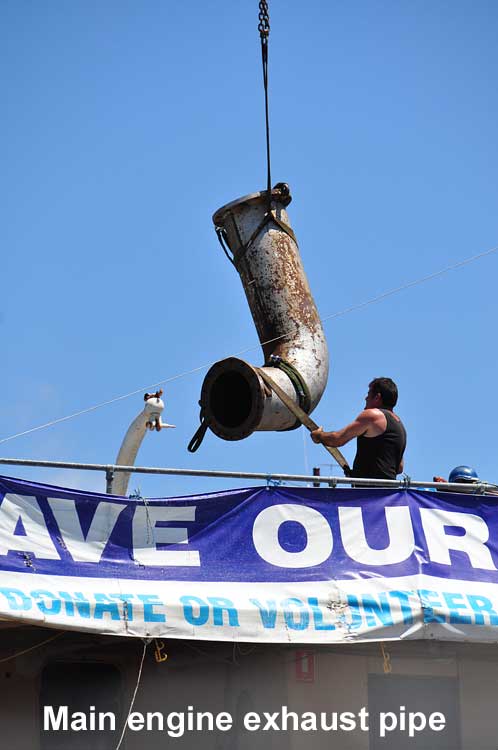 Main engine exhaust pipe – This is a 600 kg. cast iron pipe of dramatic proportions, considering its purpose to only handle exhaust steam. Andy and Glenn loosened up the connections to allow the aft end of the condenser to be raised, but it had to be removed to permit work. Ian and with our riggers undertook this task with Tim on the crane. It is now ashore and awaits needle gunning and a coat of heat proof paint.
Main engine exhaust pipe – This is a 600 kg. cast iron pipe of dramatic proportions, considering its purpose to only handle exhaust steam. Andy and Glenn loosened up the connections to allow the aft end of the condenser to be raised, but it had to be removed to permit work. Ian and with our riggers undertook this task with Tim on the crane. It is now ashore and awaits needle gunning and a coat of heat proof paint.
Bilge piping system – Work is continuing with workshop volunteers producing the standard straight 6′ (2 metre) lengths in steel. These are then sent out for galvanising by sponsor Industrial Galvanisers. They will be installed, with the next task being fabrication of branch connections and bends to connect them all together. See also industry donated pipe bends and flanges.
Auxiliary pumps and engines – Crew have been busy inserting auxiliary machinery and equipment into the engine room. To achieve this, the teak skylights were removed so that our loaned crane could access the engine room.
 A pre-task has been the repair of engine and pump stands by the ship fabricators and final needle gunning and painting by Col.
A pre-task has been the repair of engine and pump stands by the ship fabricators and final needle gunning and painting by Col.
Fan engine and base – the Howden fan engine was overhauled by Wes, while the fan itself was dismantled and re-riveted by Don. The fan has been run up to 170 revolutions on air, but needs to be tested at least 360 revolutions to ensure that the fan balance is good – a bigger air connection is needed.
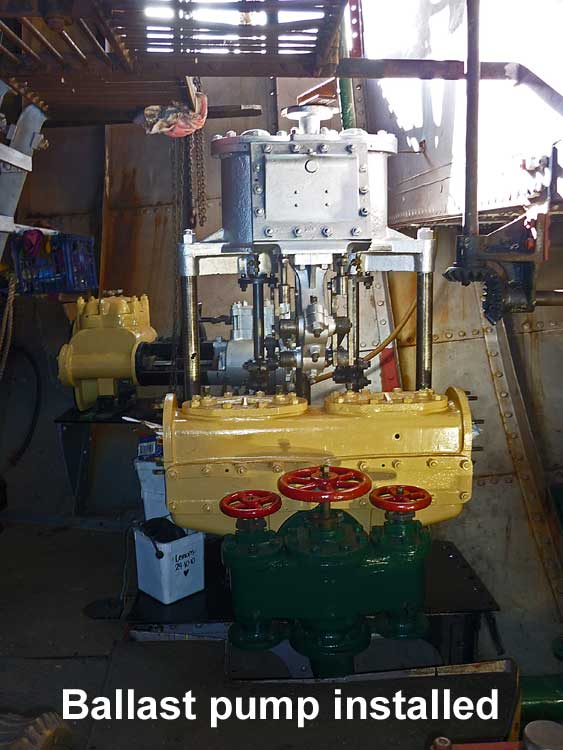 Ballast pump and sea inlet valve – They were made by Dawson and Downie and is the largest reciprocating pump in the Sydney Heritage Fleet collection. The pump is needed to move ballast water from the peak tanks around the ship to alter trim or freeboard, but as this pump is also the emergency condenser cooling pump, it is connected to the 6″ (150 mm.) ballast inlet (sea) valve located down aft starboard side.
Ballast pump and sea inlet valve – They were made by Dawson and Downie and is the largest reciprocating pump in the Sydney Heritage Fleet collection. The pump is needed to move ballast water from the peak tanks around the ship to alter trim or freeboard, but as this pump is also the emergency condenser cooling pump, it is connected to the 6″ (150 mm.) ballast inlet (sea) valve located down aft starboard side.
The pump was dismantled ashore, then reassembled and test run (see last report), and then broken down into the main parts for craning back into the ship by Tim, Ian and team. Ian and Owen have installed the pump components and reconnected its piping. Absolutely great to see this large auxiliary back in place and freshly painted.
Circulating pump and its Matthew Paul enclosed crankcase engine – An extraordinary number of people have worked on this important auxiliary. The engine and pump were pulled out years ago by the late Doug Swanson and his team. Barry and team rebuilt the steel base plate and Onzie’s fabrication team riveted it back place. Wes overhauled the engine and Col did the paintwork.
The circulating pump is a 9″ (225 mm.) bronze centrifugal type and was in good condition. New wear rings were cast in bronze to a pattern made by Ken, then machined by Bill and installed by Glenn. A new pump drive shaft was needed so Tim arranged a donation of suitable material from Hallidays Engineering. Brian and Bill then produced this component with Andy matching the new shaft flange to the engine. Bill turned up two new Vesconite bearing bushes and the pump is now ready for final installation, which will happen when all condenser shell repairs are complete.
Diesel alternator sets – The original Sissons 110 volt DC generator sets has been restored but will not be reinstalled until later. A restored John Oxley must however, have a 415/240 volt electrical system as RCD protection is mandated. This is not possible with the old DC set.
Normally, we would be seeking sponsorship for diesel gen sets much later in the restoration; however, we were surprised when two gen sets from the Endeavour replica became available and were basically gifted to the John Oxley for the princely sum of $1 each! These are in good condition and were only replaced because super quiet gen sets were being installed in Endeavour. Very special thanks to our friends in Australian National Maritime Museum for their support.
The smaller Onan 28 kVa set will handle the normal operating loads and comes with a sound proof cabinet. The larger Onan 87 kVa set will handle additional loads such as special event lighting, welders, etc. and will also serve as a backup unit. Given their good condition and moderate running hours, both sets should last us a long time.
Both gen sets were dismantled to extract them from the Endeavour engine room. Volunteers Glenn and Tony reassembled the engines and alternators onto their respective stands with assistance from Col on the forklift. Next task is for our electricians to tidy up and reconnect the electrical systems in preparation for the engineers to give them a test run.
Planning
A plan has been drawn up for the completion of the hull and to re float the ship. It includes all the steps and the sequences to seal the hull.
Volunteers
As the project approaches re float, there is a need to accelerate progress. The work will become more complex, more work teams will be needed and more materials must be sourced.
Volunteers sought for identified projects:
| • | Deck side – people to strip out and store engineers’ cabins so that the fabricators can repair the deck steel beneath. |
| • | Mast needle gunners – scaffold has been erected – need people comfortable and qualified at heights to descale and |
| paint the mast. | |
| • | Machinery space cleaners, painters – removing gear, cleaning down, painting |
| • | Hull plate caulkers – part of the fabrication team. |
| • | Fabricator skills – boiler work and piping in machinery spaces. |
| • | Leadership team – opportunity to get really involved – you can be part of the existing team, or have not yet joined up. |
| Specifically we need project leaders on deck, in the engine and boiler room and in the workshop. | |
| • | Business, promotion, fund raising and sourcing gear and materials – do you have skills? |
And we need support from business and industry. Are you able to provide steel, tools, fastenings, or products and services to the project?
Industry supplied materials and goods:
A big thank you from all of the volunteers
To visit the project or help with materials or services, contact Jon Simpson on (02) 9298 3888 or drop in on the project and ask to see Tim Drinkwater or one of the John Oxley team.
Book release
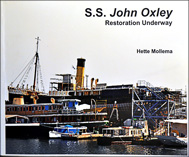 A book on the restoration of the John Oxley is now available via an on-line publisher. If you have had any association with the ship then this book is a must. Read the summary and review
A book on the restoration of the John Oxley is now available via an on-line publisher. If you have had any association with the ship then this book is a must. Read the summary and review
